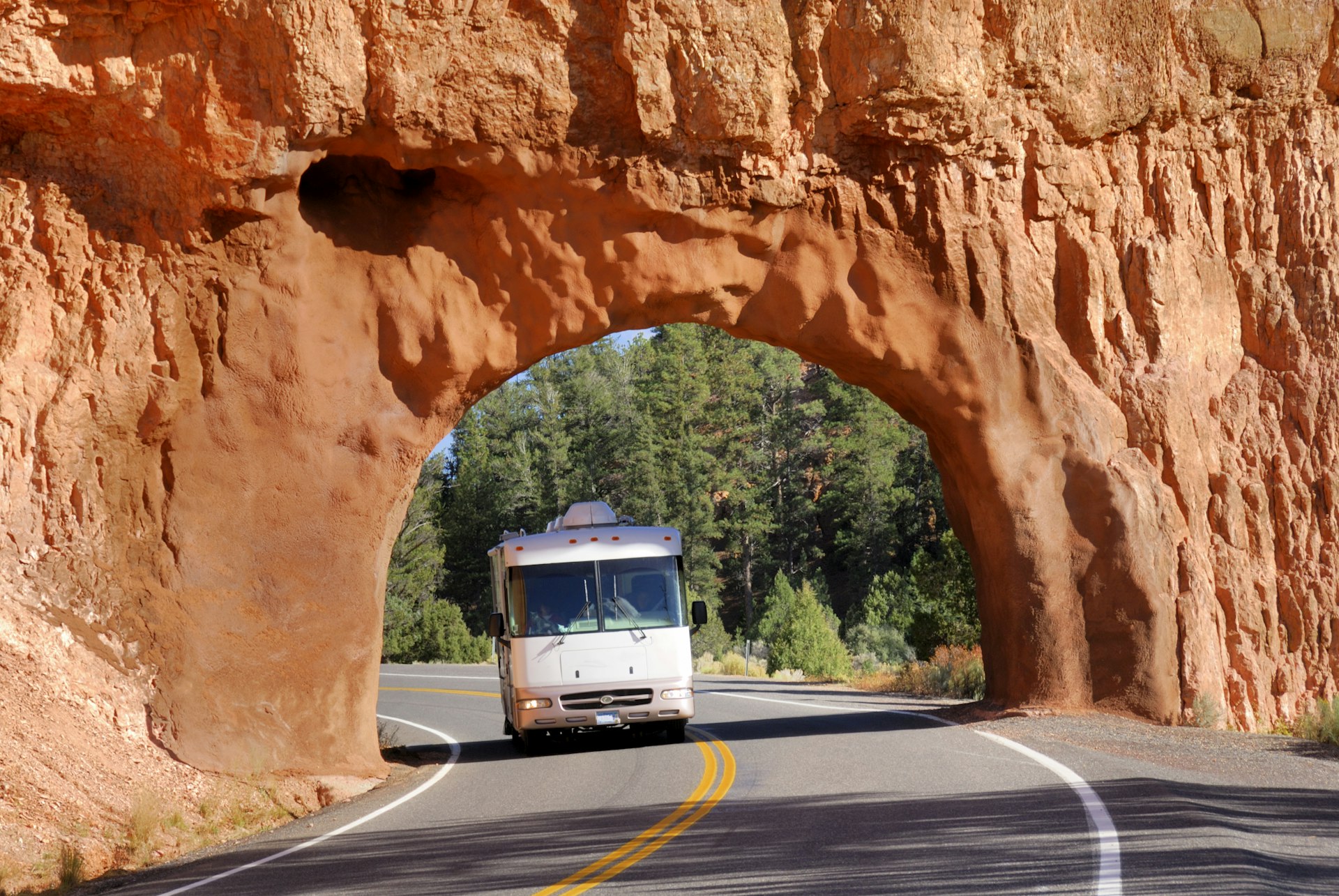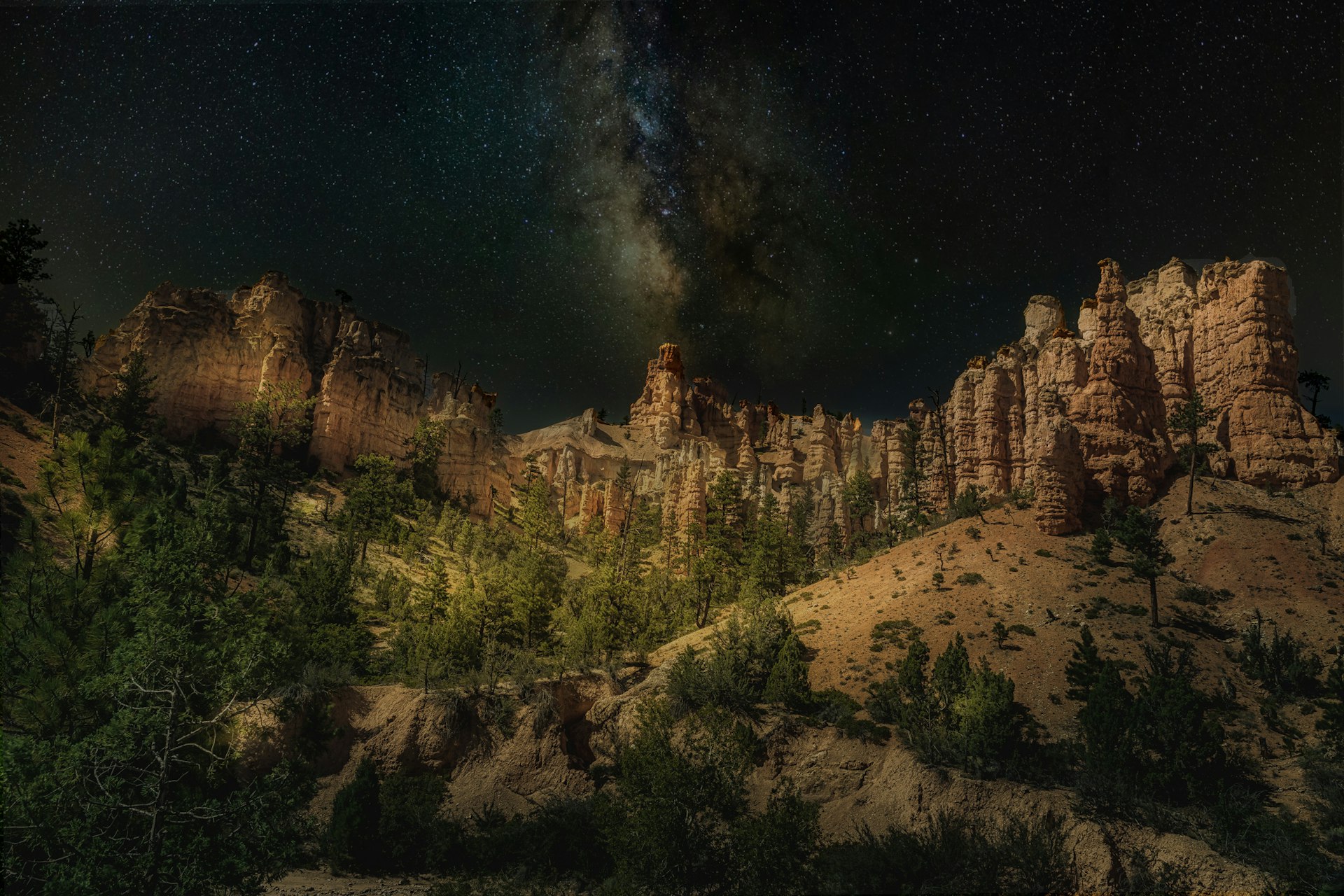The smallest of Utah’s “Mighty 5” national parks, Bryce Canyon packs a big punch. The first time you clap eyes on its iconic hoodoos – those otherworldly rock spires striped with orange, pink and red – is a moment you’ll never forget, even if you’ve seen photos of them before. This incredible park is home to more hoodoos than anywhere else in the world.
Bryce Canyon’s high elevation, averaging more than 8000ft but reaching almost 10,000ft at its loftiest points, gives this national park an edge. The seasonal cycle of freezing and thawing water repeatedly over millennia has transformed the soft sandstone and limestone into an utterly unique landscape. Despite its name, Bryce is not actually a canyon but rather a plateau (a canyon is formed by flowing water).
Epic hiking trails skirt the plateau rim before diving 1000ft down into the forest of alien pinnacles, fragrant juniper trees and centuries-old bristlecone pines. Here is everything you need to know about planning a visit to Bryce Canyon National Park.
When should I go to Bryce Canyon National Park?
More than half of the visitors to Bryce Canyon National Park go between June and the end of September, and for many, summer is the best time to visit. Bryce Canyon’s higher elevation means that the average high temperature in July is a blissful 79°F –a far cry cooler than the average of 100°F in Arches and Canyonlands or nearly 90°F in nearby Zion National Park.
In 2023, Bryce Canyon National Park’s busiest month was September, with 367,425 visitors, while January saw just 29,457 adventurers make the trip. The winter months can bring a powdered-sugar dusting of snow atop Bryce Canyon’s “fairy chimneys,” providing an even more magical setting, though some trails and accommodations are closed.
How much time should I spend at Bryce Canyon National Park?
Some travelers visit Bryce Canyon as a day trip from Zion National Park (about 80 miles, a 1.5-hour drive from Zion’s east entrance), but it’s worth staying at Bryce Canyon for a full day or two. (How do you choose between Utah’s top national parks? Don’t! See them both.)
Bryce shows off its true colors at sunrise and sunset when the amphitheater of hoodoos looks like it’s been set alight with a golden-red glow. After the sun has departed, Bryce Canyon’s clean, dry air promises excellent nighttime visibility for stargazing, reaching all the way to the Andromeda Galaxy 2.5 million light-years away.
Is it easy to get to and around Bryce Canyon National Park?
Yes, Bryce Canyon is easy to visit if you have a car – it’s just a few hours’ drive from the closest airports and major cities.
During the busier months of April through October, shuttle buses are available to get visitors around the park. The shuttle bus is free to ride with park admission and reservations are not required. There are 15 stops, nine of which are in the park; it also stops at some hotels in Bryce Canyon City outside the park entrance, where you can leave your car. Unlike at Zion National Park, the shuttle bus at Bryce Canyon is not mandatory, and visitors are allowed to drive their own vehicles into the park.
Cycling is also a great way to get around, and you can ride a bike to every major trailhead. The paved multi-use path that runs through the park goes to the Inspiration Point overlook and, beyond the park, it connects with the Red Canyon Bicycle Trail, which takes you past even more hoodoos and awesome rock formations outside Bryce’s boundaries.

Top things to do at Bryce Canyon National Park
Bryce Canyon’s hoodoos are the stars of the park, and you’ll want to spend as much time as you can gawking at them from every angle and letting your imagination – and your feet – roam. Many hoodoos here have evocative names, such as Thor’s Hammer, Tower Bridge and Silent City, and the Native Paiute believe that the formations are ancient “Legend People” who were turned to stone as punishment for wrongdoing.
The Rim Trail, one of Bryce Canyon’s easiest hikes, traces the upper edge of the plateau, overlooking the bowl of hoodoos below and linking up several viewpoints. While crowds cluster at these viewpoints because they are also accessible by car, you can walk a short distance along the Rim Trail to admire the scene in solitude.
But you can’t leave Bryce without walking among these iconic formations instead of just seeing them from above. A handful of hiking trails leave the rim and descend thousands of feet into the maze of stunningly sculpted high-mountain desert, threading their way through the hoodoos. The most popular hike in Bryce Canyon National Park is the Queen’s Garden–Navajo Loop Combination Trail. It hits Bryce’s signature features in a relatively short amount of time and starts (or ends) with an iconic series of switchbacks between high ocher-colored canyon walls.
A quieter and more challenging hiking option is the Fairyland Loop, an eight-mile day hike that gives a good workout thanks to the 1900ft of elevation gain. The trail meanders around hoodoos, down into washes, up and over saddles and past ancient bristlecone pines that cling to the rocky cliffsides for dear life.
My favorite thing to do at Bryce Canyon National Park
There are some seriously epic viewpoints where you can spy on the hoodoos to your heart’s content, but I don’t think any spot is as cool as surveying the scene from a horse saddle. On my last visit to Bryce Canyon, I signed up for a three-hour horse-riding adventure with Canyon Trail Rides, the park’s official concessioner, which takes riders out on Peekaboo Loop from April through October.
My horse for the day was an ornery, sandy-colored boy named Twerp, and our guide added amusing commentary, telling stories and pointing out rock formations along the way.
Unless you have your own horse, booking with Canyon Trail Rides is the only way to see this national park from a saddleback perspective. Trail rides book up quickly, so reserve as far in advance as you can. Even if you’re on foot instead of on a horse, the Peekaboo Loop is one of the best hikes in Utah.
How much money do I need for Bryce Canyon National Park?
The standard entrance pass for Bryce Canyon National Park costs $35 per vehicle or $20 per person if you’re visiting on foot or bicycle, and it’s valid for seven days. If you’re visiting more national parks on a road trip through Utah and beyond, it’s worth buying the America the Beautiful pass for $80. It’s valid for a year at all national parks and federal recreation land across the country for one vehicle or four per-person entry fees – arguably one of the best travel deals available.
There’s a lodge and two campgrounds inside the park. Bryce Canyon Lodge costs from $200 to $330 per night depending on the season and size of the room. Campgrounds cost $30 a night for both tents and RVs. At certain times of the year, campsites are first-come, first-served, but in the busiest season (mid-May to mid-October), you must book at recreation.gov in advance.

What is the closest city to Bryce Canyon National Park?
Bryce Canyon City sits at the entrance to Bryce Canyon National Park. Calling it a city is generous, but it has a handful of hotels and restaurants. The towns of Tropic and Cannonville, east of Bryce Canyon National Park, have a few more options for both accommodations and eating.
Where’s the best place to stay near Bryce Canyon National Park?
Bryce Canyon National Park has two in-park campgrounds, as well as the historic Bryce Canyon Lodge, which opened in 1925 and is perfectly set between the Sunrise Point and Sunset Point scenic overlooks, offering trailheads on your doorstep. Try to book a cabin if one is available – these spots are more charming than the motel-style rooms, which feel a little dated (but not in a cute way).
South of Cannonville, Bryce Glamp & Camp has gorgeous geodesic domes that feel like a home away from home, with kitchenettes, full bathrooms and plush mattresses. Wind down in the evening at your own outdoor gas firepit, watching the fading sunset light play on the quiet red-rock landscape.
Keep planning your trip to Utah:
Make the most of your America the Beautiful Pass and visit Utah’s other national parks
Explore on foot with six of the best hikes in the state
Bring the whole family with our guide to visiting Utah with kids in tow
